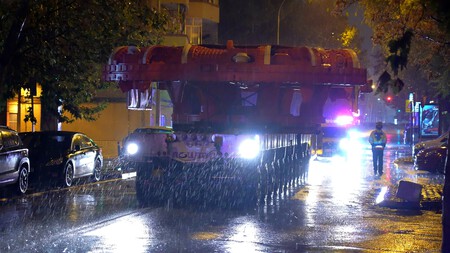In Madrid there are already the pieces of one of the largest machines that will work in the city’s underground in the coming years. This is Mayrit, the EPB tunnel boring machine from 98 meters long and 1,500 tons in weight whose transport started in Germany, continued along the Rhine to Rotterdam and continued by boat to the port of Santander. After that journey, a special convoy has completed more than 450 kilometers by road to take its modules to the future Comillas station, where it will prepare to excavate the new section of Line 11 between Plaza Elíptica and Conde de Casal.
The work on which Mayrit will work is part of a broader intervention that the Community of Madrid describes in 2025 as the largest expansion of the Metro network in the last decade. Official data published in November put progress at 34% and maintain a budget of 518 million euros to complete the new section and the planned stations. The regional government maintains the year 2027 as a reference to close this phase of the project.
Mayrit is already in Madrid: one hour left to convert its parts into a single operational machine
When dealing with a machine of this size and complexity, each phase of the process requires precision that goes far beyond conventional engineering. Mayrit’s journey towards Spain began long before it appeared on the road: it started in Schwanau, the German town where Herrenknecht completed its manufacturing after about 20 months of work. There, more than a thousand kilometers from Madrid, the tunnel boring machine was assembled for the first time in June 2025 to carry out initial verifications. This assembly showed the magnitude of the next step: converting the machine into a set of parts capable of traveling around Europe without risks.
Disassembling it was not a quick procedure. For the next two months, Herrenknecht teams dedicated themselves to separating each module following a sequence calculated to the millimeter. The result was a set of sections ready to begin an international tour.
The disembarkation in the port of Santander marked the beginning of the last stage of Mayrit’s journey, a phase that requires coordination very different from that of river and maritime transport. The pieces arrived distributed in separate shipments and were transferred to prepared platforms, a process that is carried out with specialized equipment to avoid any unexpected displacement.

The organization of the road transfer incorporated common protocols in special transport, with large-tonnage vehicles escorted by technical teams in charge of checking clearances, turning radii and urban accesses. The authorities confirmed that the advance was carried out mainly at night to reduce interruptions and facilitate maneuvers in the most delicate sections of the route. The arrival in the Comillas area required a final deployment of personnel and machinery to accommodate each piece in the work area, where the assembly phase that will transform this set of modules into a single operational tunnel boring machine is already awaiting.

The arrival of the pieces also marks the beginning of a phase that, according to forecasts released between June and November 2025, may extend until March 2026. Assembling a TBM requires joining modules in a strict order, connecting hydraulic and electrical systems, and performing tests that are concentrated between late January and February. It is a sequential process that is not resolved in a few days and that determines the date on which the machine will be able to start digging at the beginning of March.
The official documentation describes Mayrit as an EPB machine adapted to the geotechnical characteristics of the layout. Its operation is based on maintaining a balance of pressures that prevents unwanted movements on the surface, especially relevant in urban environments. To sustain this process, shifts of specialists are involved who manage the control and evacuation systems of the excavated material. The expected performance, close to 15 meters per day, will be decisive in setting the pace of mechanized progress.

Comillas will be the point from which Mayrit will begin the mechanized section, according to the forecasts that the Community of Madrid has been detailing since June 2025. From there it will advance to Conde de Casalwhile in parallel the manual excavation of about 700 meters towards Plaza Elíptica progresses, started in September with a performance of close to 50 meters per month.
The beginning of the excavation will mark the jump between the preparatory work and the actual progress of the tunnel that will transform this section of Line 11. With each meter excavated, the planned layout will get closer to its final shape and will allow the progress of the project to be measured more clearly. It is a significant element within regional planning to reinforce mobility in one of the areas with the most demand on the network.
Images | Community of Madrid
In WorldOfSoftware | Malaga has become a magnet for the most luxurious yachts in the world: the latest, that of the co-founder of Google
